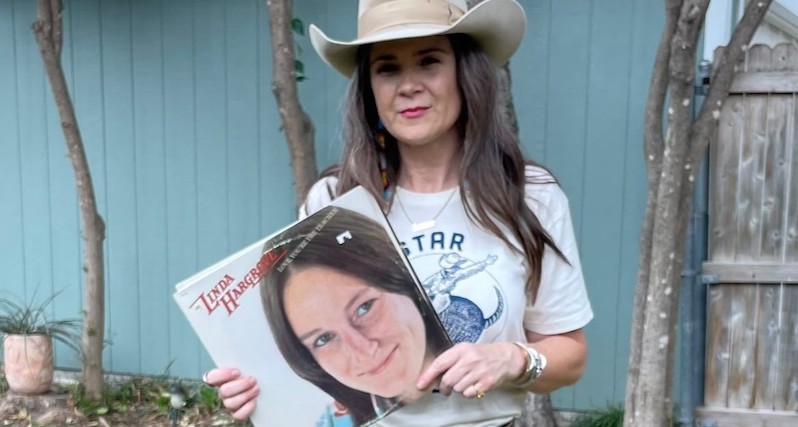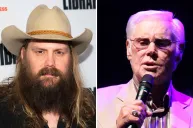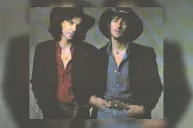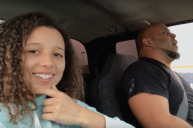Despite being a before-her-time talent as a rock-reared and country-minded singer, songwriter, session guitarist, engineer and producer, Linda Hargove's mostly mentioned, when she's mentioned at all, as the answer to a trivia question: who co-wrote "Tennessee Whiskey" with Dean Dillon?
Videos by Wide Open Country
Though it's certainly a positive that Hargrove's way with words has been part of the "Tennessee Whiskey" discourse since Chris Stapleton immortalized the song in 2015, it's a shame that she's not known for her entire body of written and recorded work. Her 1970s back catalog as a solo artist alone warrants praise, though songs that barely made a dent in the charts then remain hidden away, unavailable on Spotify and untouched by reissue labels (though easy enough to find in a used vinyl bin near you).
What follows is a story that's inspiring at times and tragic at others about a true songwriting genius and free spirit.
The Emergence of Session Guitarist and Songwriter Linda Hargrove
A child of the 1950s and 1960s, Hargrove's first love was rock 'n' roll. The Tallahassee, Fla. native played in hometown rock and R&B bands starting at age 16. Countrified material by Bob Dylan, Hargrove's guitar and songwriter hero, plus a 1969 trip to Nashville with psychedelic rockers After All opened the promising songwriter's ears to country music.
"I liked Nashville from the first," Hargrove shared in a 1977 press release. "I was rock 'n' rolled out. I couldn't have told you what the Top 10 was in country music then, but I felt the more earthy, simple and honest the music was, the better. I decided if I wanted to write songs, Nashville was the place I should be, so I went back to stay. I grew into country music in Nashville. Before that I had thought [country & western] was all cornbread and bouffant hair, but I met so many creative people it changed my thinking right away."
Hargrove moved to Music City in the summer of 1970, driving the Datsun she'd sleep in some nights and bringing only her guitar, clothes, and $75. A job at the Red Dog Saloon barely kept Hargrove afloat, if only because it offered her three sandwiches a day and all the beer she could drink.
A side gig babysitting for Sandy Posey, the country performer best known for her version of Martha Sharp's "Born a Woman," landed Hargrove her first ally within the music business. Posey introduced Hargrove to Pete Drake, the Country Music Hall of Fame producer and session musician Hargrove would've at least known for his iconic steel guitar contribution to Dylan's "Lay Lady Lay."
"Linda Hargrove was one of Pete's favorite writers because she was so hungry to be in the music business," Rose Drake, the Hall of Famer's widow, explained. "He taught her how to be an engineer. Sometimes he would just go into the studio and play, and she would be the engineer. She learned everything she could learn, and he was always the one where if a young artist came to town, he just wanted to bring them into our family. Sometimes they were with us more than actual family were."
To help his new understudy afford a roof over her head while she sharpened her songwriting talent, Drake positioned Hargrove to fill roles rarely held by women, then and now, from session work as a guitarist (a trail previously blazed by Velma Smith) to gigs producing commercial jingles.
"At the time, scale [for musicians] was $90 a session," Hargrove shared in a 1977 press release. "It had been a long time since I'd seen $90 at one time. I followed Pete around like a puppy dog, learned how to engineer, played every time I could, met everyone I could and listened and studied everything that was happening in country music. It was like a songwriter's college."
Due to inflation, $90 in the early 1970s is equivalent to over $600 in 2022. These very lucrative session gigs continued well into Hargrove's solo career, as evidenced by her contributions to albums by Leon Russell, Tommy Cash and Slim Whitman.
Drake wasn't the only country or pop gatekeeper to spot Hargrove's undeniable promise. Michael Nesmith, a former Monkee and prime mover in the development of country rock, became a Hargrove collaborator. The pair's co-writes include Lynn Anderson cut "I've Never Loved Anyone More" and "Winonah," a song recorded separately by both co-writers.
Outside cuts of Hargrove songs by big-name artists date at least back to 1971, when bubblegum pop hitmaker Tommy James recorded "Rosalee" for his country album My Head, My Bed & My Red Guitar. As word of her songwriting prowess spread, major labels came calling for Hargrove the solo artist.
Linda Hargrove's Discography (1973-1981)
Debut album Music is Your Mistress (Elektra, 1973) introduced Hargrove with two of her best-known compositions: country woman in a big pond-themed "New York City Song," which got cut the prior year by both Tanya Tucker and Jan Howard, and the punchy "Let It Shine," a crossover pop, country and easy listening hit in 1975-'76 for Olivia Newton-John.
One year later, Elektra released Blue Jean Country Queen. Its title track conveys a similar message as Conway Twitty's "Boogie Grass Band," Travis Tritt's "Put Some Drive in Your Country" and other songs that champion a steady diet of not just country music but other roosty, emotionally-driven sounds. "Well, don't you know I love my country music, but I can't deny I love the blues/ Such sweet, sweet Southern music, when you feel it touching you," goes the song's catchiest stretch.
Or at least that's one interpretation. Country artist Summer Dean learned the song a few years ago while in a honky-tonk cover band. She loved "Blue Jean Country Queen's" lyrics and their message enough to cover it for her 2021 album Bad Romantic.
"The second verse spoke to me the most," Dean told Wide Open Country. "She says, 'I'm a blue jean country country queen, I read it in a magazine and I've tried hard to understand and I wonder what it means/ That I'm a blue jean country queen, caught up somewhere in between the fading of a fever and the dawning of a dream.' I was like, 'Oh, that is so great.' Art is art is art is art, so I don't know what it meant to Linda. What it meant to me when I heard the song and why it related to me so much is the [theme of a] down-home girl making it for herself and chasing her dreams. I don't know if that's what Linda meant, but that's what I heard."
Laurence Leamer's 1996 book Three Chords and the Truth: Hope, Heartbreak and Changing Fortunes in Nashville devotes an entire chapter to Hargrove's mid-'90s attempt at a country music comeback. Leamer posits that Hargrove's three-month recuperation from a health scare while Blue Jean Country Queen was being promoted killed any potential momentum, especially since it forced the cancellation of once-in-a-lifetime opening dates for the Eagles in Louisville and Knoxville.
Dean hopes that a cover some assume she wrote about herself (plus her band's inclusion of Hargrove's "Mexican Love Songs" in its live set) points her fans to the back catalog of Hargrove, which continued in 1975 with Capitol Records debut Love, You're the Teacher.
Hargrove's third album is her best solo effort, start to finish. It's her only LP to chart, peaking at No. 45, and features her only Top 40 country single, "Love Was (Once Around the Dance Floor)." Other selections tell richly-told stories spanning the gamut of infatuation ("Love, You're the Teacher"), loss ("Half My Heart's in Texas," which got cut by Ernest Tubb) and vengeance ("Time Wounds All Heels"). It also includes Hargrove's version of a song she wrote that became a No. 1 country hit for Johnny Rodriguez, "Just Get Up and Close the Door."`
Two additional Capitol albums failed to build off Love, You're the Teacher's moderate success. Just Like You (1976) brought more star power, with innovative guitarist Chet Atkins guesting on "Your Love Sure Saved Me From Myself" and "We've Gone As Far As We Can Go" (Asleep At the Wheel cut the latter). Country artist Melba Montgomery joins voices with Hargrove on Nesmith co-write "Winonah," while Rodriguez contributes harmony vocals to multiple songs, including "Down to My Pride."
Hargrove's final mainstream LP, 1977's Impressions, brought us "Nashville, You Ain't Hollywood." It's quite the kiss-off for an industry that at the time got criticized for favoring the pop accessible hits of Kenny Rogers and (to Hargrove's benefit) Newton-John over the grittier stories told by tradition-bound singer-songwriters. Per Leamer, Hargrove wrote the song after attending a highfalutin CMA Awards ceremony.
"I wanted to say, 'Hey, look at what we're doing to our town'," Hargrove shared in a 1977 press release. "A lot of people around here are forgetting where they came from, or at least they're acting like they forgot."
A third major label, RCA came calling in the late 1970s. That deal resulted in the single "You are Still the One" plus its fantastic B-side, "I Forgave (But I Forget To Forget)."
According to Leamer, Hargrove's RCA stint never really got off the ground because the label sought to change her blue-collar and blue jean image.
"They asked her to discard her jeans, to wear outfits frilly and feminine and bright, and dress up her music in the same way, to try to sound like Barbara Mandrell, the current queen of country pop," Leamer wrote. "Linda tried, how she tried, but selling out is easier to do if you aren't any good, and the album was never released."
Though Hargrove never became a household name, her entire major label output (plus an obscure 1978 LP on Zeus Records) stands the test of time because she wrote and recorded empathetic material that should still ring true to a large chunk of country's target audience.
"I think the general purpose of my songs is to help people relate to their own feelings," she told Country Music People in 1979. "They feel like somebody's finally found the words to express what they're going through inside."
Like just about everyone who recorded country music in Nashville back then, Hargrove made albums with her fellow A-list session musicians. On Love, You're The Teacher alone, you'll hear the generational talents of drummer Buddy Harman, bassist Bob Moore, keyboardist Hargus "Pig" Robbins, guitarist Jimmy Capps, fiddler Johnny Gimble and backup singers The Jordanaires.
A New Song
In the early 1980s, Hargrove married Charles Bartholomew, a Navy veteran and graduate of Vanderbilt University, and devoted her life to Jesus.
At least one gospel album, 1981's A New Song, got released under her married name, Linda Bartholomew. Hargrove had written top-notch country-gospel songs all along, such as "When He Leads His Lambs Away," "The Only Man-Made Thing in Heaven are the Scars on Jesus' Hands" and other selections from the '70s. These songs serve a different purpose, though. They're for an independently-released extension of a family ministry, not another attempt at Nashville stardom— though the album does feature some of Music City's best talents, namely John Conlee's go-to guitarist, Brent Rowan.
During her time away from the country scene, Hargrove defeated some of the personal demons that slowed down a career that by 1978 found her performing on the Grand Ole Opry stage. Indeed, text on the rear cover of A New Song credits Hargrove's salvation experience with freeing her from "nicotine addiction and all drug addiction, especially cocaine and alcohol."
Some sources credit Hargrove with a second and seemingly impossible to find gospel album, 1987's Greater Works.
As Hargrove drifted away from country music, a co-write from her recent past that'd eventually define her career got its first wind.
"Tennessee Whiskey"
Late in her initial Nashville stay, Hargrove met Dillon, a rising songwriting legend, after a performance. (Dillon claims this took place at the Bluebird Cafe, which doesn't add up because the venue opened in 1982, a year after the song's original recording by David Allan Coe got released as a single).
"I remember going to the Bird and the reason I wanted to go was to see her because I was a big fan of Olivia Newton-John," Dillon told Wide Open Country. "I wanted to know who wrote ['Let It Shine']. When I looked it up and her name was on there, I thought, 'Man, ain't she playing at the Bluebird here pretty soon?' Or someone told me she was. I went there that night and checked out her set. When she got through, I walked up and introduced myself. We just started talking about songs, really. I remember her sister kept giving me the evil eye for some reason. We wound up going home together anyway.
"The reason we went home together is I told her about the idea I had [for 'Tennessee Whiskey']," Dillon continued. "She loved it and wanted to write with me. We went to—I think it might have even been to her place—and wrote the song. And again, it's that magical witching hour of 4 a.m. in the damn morning. I don't remember it taking us a real long time to do. It happened pretty quick because the chorus was pretty much hammered and nailed. We had that I think before we got home. The verses were pretty standard stuff back in that day, 1-4-5 chords and whatever. I thought, and she did too, that we'd wrote a pretty damn good song. "
Dillon added that his platonic connection with Hargrove only lasted about six months. Of course, the first few hours of that half-year accomplished enough creatively for Justin Timberlake's performance of "Tennessee Whiskey" with Stapleton at the 2015 CMA Awards to shift the writer of "Nashville, You Ain't Hollywood's" name to the forefront.
"I had a lot of respect for her and a lot of admiration for her and her ability," Dillon said. "Ninety-nine percent of the records back in those days were written by guys, and then here comes this wonderful free spirit who actually sings her ass off and writes her ass off. I was drawn to that like a moth to a flame. I had never to that point sat down and written with an established female. I'd always hung out with [Frank Dycus] and was about to go on a four-year exploration with Hank Cochran. I don't think I had written with any females at all to that point. It was refreshing. She came at things from a different angle than most writers, and that's what made her great."
A recurring headline since 2015 reveals that George Strait, who frequently dipped into Dillon's creative well in search of hits, turned down an early 1980s chance to record "Tennessee Whiskey."
"Obviously he could've sang the shit out of it, but he just didn't hear it for himself," Dillon recalled. "He didn't say it was a bad song or I hate that thing. He just didn't feel it, and if you don't feel the song, your performance is going to suffer pretty bad on it. Just like everything else, I was like, 'Whatever, onto the next song.' But lo and behold did it ever come back to bite him in the ass (laughs)."
George Jones scored a No. 2 hit in 1983 with "Tennessee Whiskey." Leamer wrote that Jones' success plus the subsequent rise of The Judds and other acts singing the kinds of story-songs Hargrove had written all along encouraged her to give country music another go.
By 1985, Hargrove was back in Nashville, where she worked in publishing on Music Row, cultivating such young talents as future solo star and hit songwriter Phil Vassar.
"Linda was a believer when nobody else was," Vassar told the Tallahassee Democrat in 2005. "She's never been a conformist and she doesn't want you to conform either."
Hargrove was diagnosed with leukemia in 1986. After being told that she had just three years left to live due to worsening health conditions, Hargrove and her husband relocated to Florida to be closer to her mother. The singer-songwriter overcame her most dire battle close to home, becoming the only patient out of 30 to survive a then-experimental bone marrow transplant treatment.
A third pursuit of Nashville stardom followed in the 1990s, a decade better suited for Hargrove's image and imagination. This, too, became touch and go, due in part to Charles Bartholomew's Alzheimer's diagnosis.
By 2005, the year Hargrove's final album, One Woman's Life, got released on CD, she once again lived in Florida. She continued to perform live, as discovered that same decade by an old acquaintance.
"The last time I saw Linda, believe it or not, I happened to be driving the coastline down there and stopped in this freaking bar and lo and behold she's playing," Dillon said. "We freaked out, both of us did, and sat there and had a cocktail and probably smoked a joint. You know, hashed around old times. It was good to see her, but I could tell then that she wasn't doing well physically. It was maybe a year before she passed away."
Hargrove died on Oct. 24, 2010 in Tallahassee. She was 61 years old.




